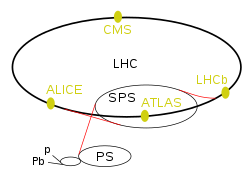 Plan of the LHC experiments and the preaccelerators. | |
| LHC experiments | |
|---|---|
| ATLAS | A Toroidal LHC Apparatus |
| CMS | Compact Muon Solenoid |
| LHCb | LHC-beauty |
| ALICE | A Large Ion Collider Experiment |
| TOTEM | Total Cross Section, Elastic Scattering and Diffraction Dissociation |
| LHCf | LHC-forward |
| MoEDAL | Monopole and Exotics Detector At the LHC |
| FASER | ForwArd Search ExpeRiment |
| SND | Scattering and Neutrino Detector |
| LHC preaccelerators | |
| p and Pb | Linear accelerators for protons (Linac 4) and lead (Linac 3) |
| (not marked) | Proton Synchrotron Booster |
| PS | Proton Synchrotron |
| SPS | Super Proton Synchrotron |
The Scattering and Neutrino Detector (SND) at the Large Hadron Collider (LHC), CERN, is an experiment built for the detection of the collider neutrinos. The primary goal of SND is to measure the p+p --> +X process and search for the feebly interacting particles. It will be operational from 2022, during the LHC-Run 3 (2022-2024). SND will be installed in an empty tunnel- TI18 that links the LHC and Super Proton Synchrotron, 480m away from the ATLAS experiment interaction point in the fast forward region and along the beam collision axis.[1][2][3][4][5]
In February 2020, the Search for Hidden Particle (SHiP) collaboration expressed its interest in neutrino-measurement to the LHC Council (LHCC). The letter of intent for SND was presented in August 2020.[6] Based on LHCC’s recommendation, the Letter of intent was followed by the Technical Design report presented in February 2021. The experiment was later approved in March 2021 by the CERN Research Board to be the ninth experiment at LHC.[1][7] In 2023, SND@LHC and FASER reported the first observation of collider neutrinos.[8][9][10]
- ^ a b "CERN approves new LHC experiment". CERN. Retrieved 2021-07-28.
- ^ "Collider neutrinos on the horizon". CERN Courier. 2021-06-02. Retrieved 2021-08-19.
- ^ "Designing the SND@LHC experiment". EP News. Retrieved 2021-08-19.
- ^ "INSPIRE". inspirehep.net. Retrieved 2021-08-19.
- ^ Pastore, A (December 2020). "Neutrino physics with the SHiP experiment at CERN". Journal of Physics: Conference Series. 1690: 012171. doi:10.1088/1742-6596/1690/1/012171. ISSN 1742-6588. S2CID 221931137.
- ^ Collaboration, S. N. D. (2020). Scattering and Neutrino Detector at the LHC. Letter of Intent. CERN. Geneva. The LHC experiments Committee, LHCC.
- ^ "Greybook". greybook.cern.ch. Retrieved 2021-08-19.
- ^ SND@LHC Collaboration; Albanese, R.; Alexandrov, A.; Alicante, F.; Anokhina, A.; Asada, T.; Battilana, C.; Bay, A.; Betancourt, C.; Biswas, R.; Blanco Castro, A.; Bogomilov, M.; Bonacorsi, D.; Bonivento, W. M.; Bordalo, P. (2023-07-19). "Observation of Collider Muon Neutrinos with the SND@LHC Experiment". Physical Review Letters. 131 (3): 031802. arXiv:2305.09383. Bibcode:2023PhRvL.131c1802A. doi:10.1103/PhysRevLett.131.031802. PMID 37540851.
- ^ FASER Collaboration; Abreu, Henso; Anders, John; Antel, Claire; Ariga, Akitaka; Ariga, Tomoko; Atkinson, Jeremy; Bernlochner, Florian U.; Blesgen, Tobias; Boeckh, Tobias; Boyd, Jamie; Brenner, Lydia; Cadoux, Franck; Casper, David W.; Cavanagh, Charlotte (2023-07-19). "First Direct Observation of Collider Neutrinos with FASER at the LHC". Physical Review Letters. 131 (3): 031801. arXiv:2303.14185. Bibcode:2023PhRvL.131c1801A. doi:10.1103/PhysRevLett.131.031801. PMID 37540863.
- ^ Worcester, Elizabeth (July 19, 2023). "The Dawn of Collider Neutrino Physics". Physics. 16: 113. Bibcode:2023PhyOJ..16..113W. doi:10.1103/Physics.16.113. Retrieved July 23, 2023.
